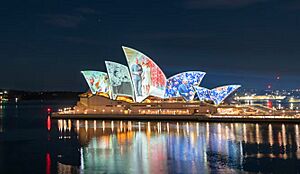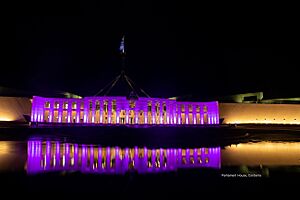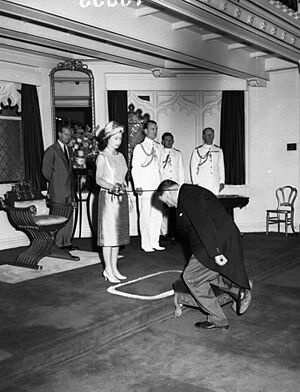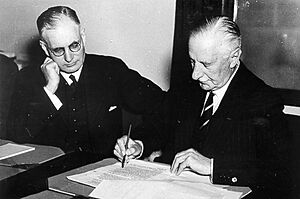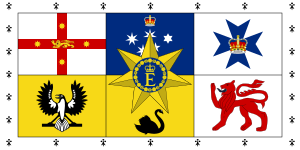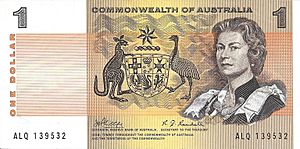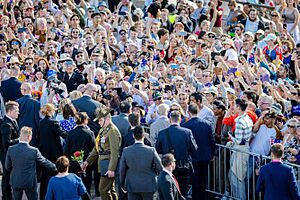Monarchy of Australia facts for kids
Quick facts for kids King of Australia |
|
|---|---|

King's Flag for Australia
|
|
| Incumbent | |
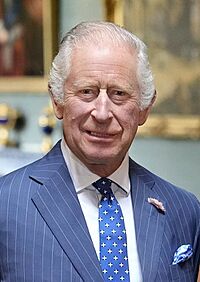 |
|
| Charles III since 8 September 2022 |
|
| Details | |
| Style | His Majesty |
| Heir apparent | William, Prince of Wales |
The monarchy of Australia is a key part of Australia's government. It means that a hereditary monarch (a king or queen whose position is passed down through their family) is Australia's head of state. Australia is a constitutional monarchy. This means the monarch's powers are set by a constitution and laws, and they work within a parliamentary democracy.
The current monarch is King Charles III. He became King on 8 September 2022. In Australia, the King is represented by the governor-general at the national level. In each Australian state, the King is represented by a governor. These representatives are appointed by the monarch based on advice from Australian leaders.
Australian law says that the person who is the monarch of the United Kingdom is also the monarch of Australia. However, the Australian monarchy is a separate role. The monarch acts only on the advice of Australian ministers. Australia is one of 15 Commonwealth realms. These are independent countries that share the same person as their monarch.
Contents
How the Monarchy Works in Australia
The monarch of Australia is the same person as the monarch of 14 other Commonwealth realms. But each realm is independent. This means the monarchy in Australia is different from the monarchy in other countries. Since the Australia Act 1986, the British government cannot advise the monarch on Australian matters. The monarch is advised only by Australian federal ministers. For state matters, the monarch is advised by state ministers.
When Did Australia's Monarchy Become Separate?
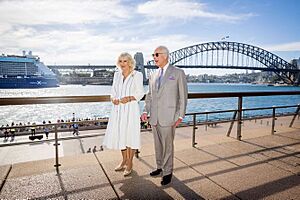
Experts have different ideas about when Australia's Crown (the monarchy) became separate from the United Kingdom's Crown. Some say it was in 1926 or 1930. This was when it was decided that governors-general would no longer represent the UK government. Others suggest it was when Australia became fully independent. This could be 1931, 1939, 1942, or 1986. The High Court of Australia has said the separation was complete by at least 1948. This was when Australia created its own citizenship laws.
It's not fully clear if each Australian state also has its own separate Crown. This means the monarch might also be considered the King of Victoria, for example. This difference could be important if Australia or a state wanted to become a republic.
What is the Monarch's Title?
The full title of the current monarch is King Charles the Third, by the Grace of God King of Australia and His other Realms and Territories, Head of the Commonwealth.
Before 1953, the Australian monarch's title was the same as in the United Kingdom. After discussions, a new title was created for Queen Elizabeth II. It mentioned Australia and other Commonwealth realms separately for the first time. This change was made law by the Royal Style and Titles Act 1953.
In 1973, the Australian government changed the title again. They removed references to the United Kingdom and "Defender of the Faith." This made the title more "distinctively Australian."
How Does Succession Work?

Royal succession means who becomes the next monarch. It is decided by a mix of old laws and newer Australian laws. Generally, the eldest non-adopted child of the current monarch inherits the throne. However, the heir must be a member of the Church of England and not a Roman Catholic.
These rules have changed over many centuries. British laws like the Bill of Rights 1689 and the Act of Settlement 1701 first set limits on who could inherit the throne. These laws came to Australia when it was settled.
Later, Australia gained more independence with the Statute of Westminster 1931. This law said that any changes to succession rules would need the agreement of all Commonwealth realms. The most recent changes happened after the Perth Agreement in 2011. This agreement removed the preference for male heirs. It also allowed the monarch to marry a Roman Catholic. These changes became law in Australia in 2015.
What Happens When a Monarch Dies?
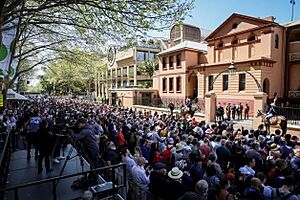
When a monarch dies or steps down (called a "demise of the Crown"), the new monarch immediately takes the throne. There is no need for a special ceremony to confirm it. It is customary for the new monarch's accession to be publicly announced by the governor-general. Governors in each state also make similar announcements. After a period of mourning, the monarch is usually crowned in the United Kingdom. This coronation is a symbolic event and not needed for the monarch to reign.
The monarch cannot simply step down on their own. The only Australian monarch to do so, Edward VIII, did so after British laws were passed.
Who Pays for the Monarchy?
Australia does not pay for the King or the wider royal family's activities outside of Australia. This includes their personal income or homes. When the monarch visits Australia, the Australian Government pays for their expenses. The Australian Government also pays a salary to the governor-general and for the upkeep of their official homes.
For example, King Charles III's visit to Australia in 2024 cost $640,000.
Where Does the Monarch Live in Australia?
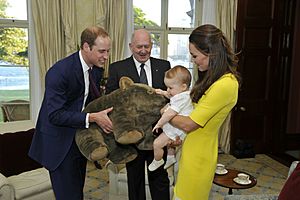
The governor-general has two official homes: Government House in Canberra (also known as Yarralumla) and Admiralty House in Sydney. The monarch does not have a personal residence in Australia.
The Monarch's Role in Government
The monarch is at the heart of many oaths of allegiance in Australia. Many government employees, like members of Parliament, judges, and police officers, must swear loyalty to the monarch. This is a promise in return for the monarch's coronation oath. In this oath, the monarch promises to govern the people of Australia according to their laws.

The oath of citizenship used to include a promise of loyalty to the monarch. In 1994, this changed to a pledge of loyalty to Australia and its values.
Who is the Head of State?
Australia's government system includes the monarch, governors, and the governor-general. The Constitution does not use the term head of state. However, the Parliament of Australia website says the monarch is Australia's head of state. The prime minister is the head of government. The governor-general's website says the governor-general is Australia's head of state in practice. A common view is that "The Queen, as represented in Australia by the governor-general, is Australia's head of state."
Some states, like Queensland, also describe the monarch as their head of state. Other states describe their governors as their heads of state.
The Monarch's Role in Lawmaking
Australia has a written constitution based on the Westminster system of government. This system gives Australia a parliamentary system of government. The monarch and governor-general have both legal and practical roles. The monarch is represented by the governor-general at the federal level. In each state, the monarch is represented by a governor.
Executive Power
Section 61 of the Constitution gives the executive power of Australia to the King. This power is used by the governor-general. The governor-general is appointed by the King on the advice of the prime minister. This is the only role the monarch must do personally. The governor-general then appoints the prime minister. Other ministers are appointed by the governor-general on the prime minister's advice. These ministers advise the governor-general on how to use executive power. This includes powers like declaring war and making treaties.
Since the King and governor-general usually act on advice, their roles are mostly symbolic. They represent the legal authority for all government actions. For example, judges are formally appointed by the governor-general, not the government. However, the governor-general also has special "reserve powers." These powers can be used without or against advice. A famous example was in 1975. Governor-General Sir John Kerr dismissed the government of Gough Whitlam.
The monarch can also dismiss the governor-general. This power was discussed during the 1975 crisis.
Parliament's Role
The Parliament of Australia includes the sovereign, the Senate, and the House of Representatives. The monarch and governor-general do not take part in making laws directly. They only grant royal assent. This means they sign bills into law. The governor-general is also responsible for calling, pausing, and ending federal parliament sessions.
All laws in Australia, except those in the Australian Capital Territory (ACT), need royal assent. This is done by the governor-general or a state governor. The governor-general signs two copies of the bill. The governor-general can also send a bill to the King for his personal decision. The King also has the power to reject a bill within one year of the governor-general signing it. This power was meant for the UK Parliament to oversee Australia's laws. However, it has never been used and is unlikely to be used in the future.
Courts and Justice
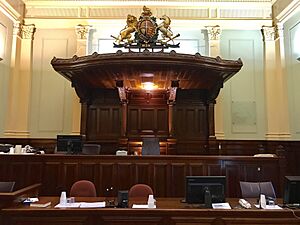
The monarch is traditionally seen as the "fount of justice." This means justice comes from them. However, the monarch does not personally decide court cases. Judicial tasks are done in the monarch's name. In most places, crimes are seen as offenses against the sovereign. Court cases for serious crimes are brought in the monarch's name, like The King [or Queen] against [Name]. This is usually shortened to R v [Name].
The power to grant mercy (a pardon) belongs to the monarch. This power is used by the governors in the states.
States and Territories
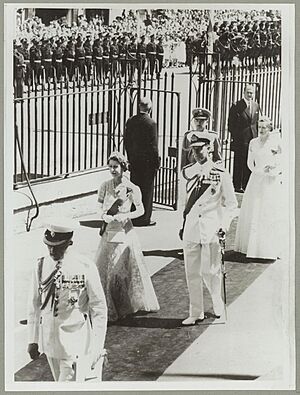
The Australia Act 1986 says the monarch appoints a governor in each Australian state. This is done on the advice of the state premier. These governors appoint executive bodies and fill vacant Senate seats. State governors are direct representatives of the monarch. They are not under the governor-general. They carry out the monarch's duties in their state.
The Northern Territory and the Australian Capital Territory are under the federal government. An administrator is appointed by the governor-general for the Northern Territory. The ACT does not have a similar position.
The monarch or the governor is also part of state parliaments. However, in South Australia, neither the monarch nor the governor is part of parliament. Bills passed by state parliaments must be signed by the governor in the monarch's name. If the monarch is in a state, they can personally use any of these powers.
The Monarchy's Cultural Role
Royal Visits and Duties
The monarch and their family have taken part in many important events in Australia. These include anniversaries, Australia Day celebrations, and the opening of Olympic Games. Other royals have also attended ceremonies involving Australia abroad.
Members of the royal family have also given private donations to Australian charities. For example, Queen Elizabeth II donated to the Australian Red Cross after bushfires in 2009.
The Crown and the Australian Defence Force
Section 68 of the Australian Constitution states that the governor-general, as the monarch's representative, commands Australia's naval and military forces. In reality, the governor-general follows the advice of the Minister for Defence. All members of the Australian Defence Force swear an Oath of Allegiance to the Australian Monarch. They promise to "resist his (or her) enemies."
Australian naval ships use the prefix His Majesty's Australian Ship (HMAS). Many parts of the defence force, like the Royal Australian Air Force, have the "royal" prefix.
Members of the royal family have led military ceremonies. King Charles III, during his 2024 visit, laid wreaths at the Australian War Memorial. He also reviewed the Royal Australian Navy in Sydney.
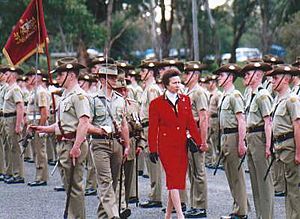
Monarchs of Australia are appointed to the highest ranks in the Defence Force. In 2024, Charles III was appointed to honorary ranks like admiral of the fleet of the Royal Australian Navy. Some members of the royal family are also Colonels-in-Chief of Australian regiments.
Australian Royal Symbols
Royal symbols are the visual and sound identifiers of the Australian monarchy. The main symbol is the sovereign themselves. The monarch's portrait has been on all Australian coins since 2024. King Charles III's portrait is now used for new coins. The monarch's image also used to be on most Australian stamps until 1973. Queen Elizabeth II's portrait is currently on the five-dollar banknote. However, this design will be replaced with one showing Indigenous Australian culture.
A crown is shown on the Queensland and Victorian state badges. It is also on various medals and awards. The crown on the Order of Australia insignia shows the monarch's role as Head of the Order. The royal anthem "God Save the King" is used on official occasions when the monarch or a royal family member is present. It was Australia's national anthem until 1984.

His Majesty The King's Flag for Australia was approved in 2024. It shows his presence and is flown when Charles is in Australia. The flag was first used during the 2024 royal visit.
The King's Official Birthday is a public holiday in Australia. It is usually celebrated on the second Monday in June. Celebrations include the Australian Birthday Honours list and military ceremonies.
Royal symbols became popular during Queen Victoria's reign. They helped encourage loyalty to the British Empire. Queen Elizabeth II said in 1954 that "the Crown is the human link between all the people who owe allegiance to me." For Australia's Indigenous peoples, the Crown has sometimes represented the loss of their land. However, it has also symbolized protection of Indigenous rights.
History of the Monarchy in Australia
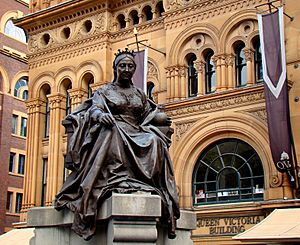
The Australian monarchy began to become independent in 1770. This was when Captain James Cook claimed the east coast of Australia for King George III. Colonies were founded across Australia. They were all ruled by the monarch of the United Kingdom. In 1901, the six colonies united to form the Commonwealth of Australia. This happened after Queen Victoria approved the Commonwealth of Australia Constitution Act. But this did not change the monarch's relationship with Australia much at first.
After the First World War, Dominions like Australia wanted their status re-evaluated. The Balfour Declaration of 1926 stated that the UK and Dominions were "equal in status." The Royal and Parliamentary Titles Act 1927 was the first sign of this change in law. In 1930, the British government agreed that the Australian Cabinet would advise the monarch directly on choosing the governor-general. The Crown became more separate with the Statute of Westminster 1931, which Australia adopted in 1942.
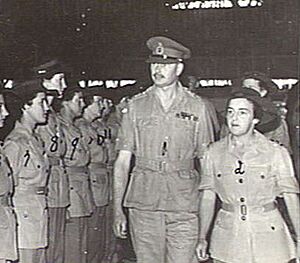
During World War II, Prince Henry, Duke of Gloucester, the brother of King George VI, was appointed governor-general. Queen Elizabeth II was the first reigning monarch to visit Australia in 1954. She was greeted by huge crowds. Her son, Charles III, attended school in Australia in 1967. Her grandson, Prince Harry, lived and worked in Australia in 2003.

The monarch did not have a title unique to Australia until 1953. The Royal Styles and Titles Act gave Elizabeth the title Queen of the United Kingdom, Australia and Her other Realms and Territories. However, Elizabeth only acted as Queen of Australia at the federal level. At the state level, she acted as Queen of the United Kingdom. State laws were still affected by the Colonial Laws Validity Act. This meant UK laws could override them.
In 1973, the title was changed to Queen of Australia. Elizabeth signed her approval for this Act in Canberra. The Australia Act 1986 removed the last connections to the British monarchy in Australia. This left a distinct Australian monarchy for the nation.
The 1999 Australian republic referendum was defeated. This was despite polls showing that most people supported becoming a republic. Many believe that disagreement among republicans about how a republic should work led to the "no" vote. Queen Elizabeth II visited Australia a year after the referendum. She said she respected the outcome and would continue to serve as Queen of Australia.
Elizabeth II, the longest-serving monarch, died on 8 September 2022. Her son, Charles III, succeeded her. His coronation of Charles III and Camilla took place on 6 May 2023. In October 2024, Charles III became the first reigning King of Australia to visit the country.
Debate About the Monarchy
Public Opinion
Many polls have been done on public support for the monarchy since 1953. Support for the monarchy reached a low point in 1998. It then rose to about 50% by 2016. After King Charles became monarch in September 2022, more polls were taken. They showed different levels of support for a republic.
Political Discussion
Former Prime Minister Julia Gillard said she wanted Australia to become a republic. However, she also said the monarch is "a vital constitutional part of Australian democracy." Current Prime Minister Anthony Albanese has also said he wants Australia to have an appointed head of state. But he has not set a date for a referendum. He believes a vote should only happen if there is strong public demand.
Some people who support a republic have called large public turnouts during royal tours "the cult of celebrity." However, others believe that royal visits are still very meaningful. Former governor-general Michael Jeffery has argued that the constitutional monarchy has helped Australia have political stability.
The idea of a unique Australian monarch, living in Australia, has been suggested sometimes. Another idea is to crown someone in the line of succession who is not expected to become monarch by current rules.
List of Monarchs of Australia
Colonial Period (1770–1901)
| Portrait | Regnal name (Birth–Death) Royal dynasty |
Reign over Australia | Full name | Consort | |
|---|---|---|---|---|---|
| Start | End | ||||
 |
George III (1738–1820) House of Hanover |
29 April 1770 | 29 January 1820 | George William Frederick | Charlotte of Mecklenburg-Strelitz |
| Governors of New South Wales: Arthur Phillip, John Hunter, Philip King, William Bligh, Lachlan Macquarie | |||||
 |
George IV (1762–1830) House of Hanover |
29 January 1820 | 26 June 1830 | George Augustus Frederick | Caroline of Brunswick |
| Governors of New South Wales: Sir Thomas Brisbane, Sir Ralph Darling | |||||
| Governor of Western Australia: Sir James Stirling | |||||
 |
William IV (1765–1837) House of Hanover |
26 June 1830 | 20 June 1837 | William Henry | Adelaide of Saxe-Meiningen |
| Governor of New South Wales: Sir Richard Bourke | |||||
| Governor of Western Australia: Sir James Stirling | |||||
| Governor of South Australia: Sir John Hindmarsh | |||||
 |
Victoria (1819–1901) House of Hanover |
20 June 1837 | 1 January 1901 | Alexandrina Victoria | Albert of Saxe-Coburg and Gotha |
| Governors of New South Wales: Sir George Gipps, Sir Charles FitzRoy, Sir William Denison, Sir John Young, Somerset Lowry-Corry, 4th Earl Belmore, Sir Hercules Robinson, Lord Augustus Loftus, Charles Wynn-Carington, 3rd Baron Carrington, Victor Child Villiers, 7th Earl of Jersey, Sir Robert Duff, Henry Brand, 2nd Viscount Hampden, William Lygon, 7th Earl Beauchamp | |||||
| Governors of Western Australia: Sir James Stirling, John Hutt, Sir Andrew Clarke, Charles Fitzgerald, Sir Arthur Kennedy, John Hampton, Sir Benjamin Pine, Sir Frederick Weld, Sir William Robinson, Sir Harry Ord, Sir Frederick Broome, Sir Gerard Smith | |||||
| Governors of South Australia: George Gawler, Sir George Grey, Frederick Robe, Sir Henry Young, Sir Richard MacDonnell, Sir Dominick Daly, Sir James Fergusson, Sir Anthony Musgrave, Sir William Jervois, Sir William Robinson, Algernon Keith-Falconer, 9th Earl of Kintore, Sir Thomas Buxton, Hallam Tennyson, 2nd Baron Tennyson | |||||
| Governors of Victoria: Sir Charles Hotham, Sir Henry Barkly, Sir Charles Darling, John Manners-Sutton, 3rd Viscount Canterbury, Sir Sir George Bowen, George Phipps, 2nd Marquess of Normanby, Sir Henry Loch, John Hope, 7th Earl of Hopetoun, Thomas Brassey, 1st Earl Brassey | |||||
| Governors of Tasmania: Sir Henry Young, Sir Thomas Browne, Sir Charles Du Cane, Sir Frederick Weld, Sir John Lefroy, Sir George Strahan, Sir Robert Hamilton, Jenico Preston, 14th Viscount Gormanston | |||||
| Governors of Queensland: Sir George Bowen, Samuel Blackall, George Phipps, 2nd Marquess of Normanby, Sir William Cairns, Sir Arthur Kennedy, Sir Anthony Musgrave, Sir Henry Norman, Charles Cochrane-Baillie, 2nd Baron Lamington | |||||
Federation (1901–present)
British Crown (1901–1939)
| Portrait | Regnal name (Birth–Death) Royal dynasty |
Reign | Full name | Consort | |
|---|---|---|---|---|---|
| Start | End | ||||
 |
Victoria (1819–1901) House of Hanover |
1 January 1901 | 22 January 1901 | Alexandrina Victoria | Widowed |
| Governor-general: John Hope, 7th Earl of Hopetoun | |||||
| Prime minister: Edmund Barton | |||||
 |
Edward VII (1841–1910) House of Saxe-Coburg and Gotha |
22 January 1901 | 6 May 1910 | Albert Edward | Alexandra of Denmark |
| Governors-general: John Hope, 7th Earl of Hopetoun, Hallam Tennyson, 2nd Baron Tennyson, Henry Northcote, 1st Baron Northcote, William Ward, 2nd Earl of Dudley | |||||
| Prime ministers: Edmund Barton, Alfred Deakin, Chris Watson, George Reid, Alfred Deakin, Andrew Fisher, Alfred Deakin | |||||
 |
George V (1865–1936) House of Saxe-Coburg and Gotha (until 1917) House of Windsor (after 1917) |
6 May 1910 | 20 January 1936 | George Frederick Ernest Albert | Mary of Teck |
| Governors-general: William Ward, 2nd Earl of Dudley, Thomas Denman, 3rd Baron Denman, Sir Ronald Ferguson, Henry Forster, 1st Baron Forster, John Baird, 1st Baron Stonehaven, Sir Isaac Isaacs | |||||
| Prime ministers: Andrew Fisher, Joseph Cook, Andrew Fisher, Billy Hughes, Stanley Bruce, James Scullin, Joseph Lyons | |||||
 |
Edward VIII (1894–1972) House of Windsor |
20 January 1936 | 11 December 1936 | Edward Albert Christian George Andrew Patrick David | None |
| Governors-general: Sir Isaac Alfred Isaacs, Alexander Hore-Ruthven, 1st Earl of Gowrie | |||||
| Prime minister: Joseph Lyons | |||||
 |
George VI (1895–1952) House of Windsor |
11 December 1936 | 3 September 1939 | Albert Frederick Arthur George | Elizabeth Bowes-Lyon |
| Governors-general: Alexander Hore-Ruthven, 1st Earl of Gowrie | |||||
| Prime ministers: Joseph Lyons, Sir Earle Page, Robert Menzies | |||||
Australian Crown (1939–present)
The date of separation of the Australian Crown from the British Crown is a matter of debate (see emergence of a separate Crown above), however the process most likely occurred in the 1930s to 1940s, and was complete by at least 1948.
| Portrait | Regnal name (Birth–Death) Royal dynasty |
Reign | Full name | Consort | |
|---|---|---|---|---|---|
| Start | End | ||||
 |
George VI (1895–1952) House of Windsor |
3 September 1939 | 6 February 1952 | Albert Frederick Arthur George | Elizabeth Bowes-Lyon |
| Governors-general: Alexander Hore-Ruthven, 1st Earl of Gowrie, Prince Henry, Duke of Gloucester, Sir William McKell | |||||
| Prime ministers: Robert Menzies, Arthur Fadden, John Curtin, Frank Forde, Ben Chifley, Robert Menzies | |||||
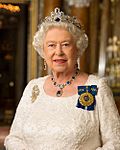 |
Elizabeth II (1926–2022) House of Windsor |
6 February 1952 | 8 September 2022 | Elizabeth Alexandra Mary | Philip Mountbatten |
| Governors-general: Sir William McKell, Sir William Slim, William Morrison, 1st Viscount Dunrossil, William Sidney, 1st Viscount De L'Isle, Richard Casey, Baron Casey, Sir Paul Hasluck, Sir John Kerr, Sir Zelman Cowen, Sir Ninian Stephen, William Hayden, Sir William Deane, Peter Hollingworth, Michael Jeffery, Dame Quentin Bryce, Sir Peter Cosgrove, David Hurley | |||||
| Prime ministers: Sir Robert Menzies, Harold Holt, John McEwen, John Gorton, William McMahon, Gough Whitlam, Malcolm Fraser, Bob Hawke, Paul Keating, John Howard, Kevin Rudd, Julia Gillard, Kevin Rudd, Tony Abbott, Malcolm Turnbull, Scott Morrison, Anthony Albanese | |||||
 |
Charles III (born 1948) House of Windsor |
8 September 2022 | Present | Charles Philip Arthur George | Camilla Shand |
| Governors-general: David Hurley, Samantha Mostyn | |||||
| Prime ministers: Anthony Albanese | |||||
Timeline of Monarchs Since Federation

See also
 In Spanish: Monarquía en Australia para niños
In Spanish: Monarquía en Australia para niños
- Australian State Coach
- List of Australian organisations with royal patronage
- Royal tours of Australia
- List of Commonwealth visits made by Elizabeth II
- List of prime ministers of Elizabeth II
- List of sovereign states headed by Elizabeth II
- Australian peers and baronets
- Wattle Queen
- King-in-Parliament


